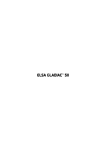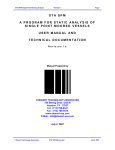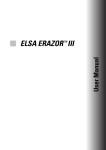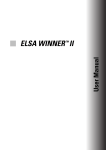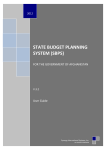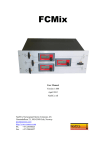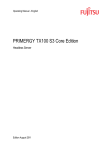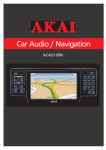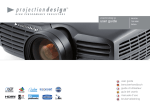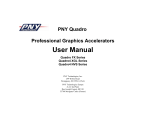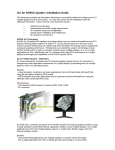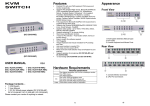Download GLoria DCC.book
Transcript
ELSA GLoria DCC
TM
© 2001 ELSA AG, Aachen (Germany)
While the information in this manual has been compiled with great care, it may not be deemed an assurance of product
characteristics. ELSA shall be liable only to the degree specified in the terms of sale and delivery.
The reproduction and distribution of the documentation and software supplied with this product and the use of its contents
is subject to written authorization from ELSA. We reserve the right to make any alterations that arise as the result of technical development.
ELSA is DIN EN ISO 9001 certified. The accredited TÜV CERT certification authority has confirmed ELSA conformity to the
worldwide ISO 9001 standard in certificate number 09 100 5069, issued on June 15, 1998.
You can find all declarations and approvals for the products, as long as they were available at the time of publication, in
the appendix of this documentation or on the ELSA website at www.elsa.com.
Trademarks
Windows®, Windows NT® and Microsoft® are registered trademarks of Microsoft, Corp.
OpenGL® API is a registered trademark of Silicon Graphics, Inc.
The ELSA logo is a registered trademark of ELSA AG. All other names mentioned may be trademarks or registered trademarks of their respective owners.
Subject to change without notice. No liability for technical errors or omissions.
ELSA, Inc.
1630 Zanker Road
San Jose, CA 95112
ELSA AG
Sonnenweg 11
52070 Aachen
USA
Germany
www.elsa.com
www.elsa.com
Aachen, June 2001
EN
Preface
Thank you for placing your trust in this ELSA product
With the ELSA GLoria DCC you have selected a graphics board which was
designed as a product for visualisation and animation. The graphics processor on the board ensures high-speed generation of on-screen graphics
making this board ideal for Digital Content Creation (DCC) applications. ELSA
products are subject to the highest standards in production and quality control, which are the foundations of consistantly high product quality.
About this manual
This manual provides all the information you will need to get the best out of
your ELSA graphics board. For instance, which resolution is best for which
monitor? The accompanying ELSA utility programs are described.
Changes to this manual
ELSA products are subject to continual development. It is therefore possible
that the information printed in this manual is not current in all respects.
Curent information about updates can always be found in the README files
on the ELSA CD.
If you have further questions or need additional help, you can rely on our
online services which are available to ELSA customers.
| ELSA GLoria DCC |
EN
Before you read on...
The installation of the ELSA GLoria DCC hardware and drivers is described in
full in the installation guide which accompanies this manual. You should refer
to that document before attempting to install your board.
| ELSA GLoria DCC |
|
EN
Contents
1 Introduction . . . . . . . . . . . . . . . . . . . . . . . . . . . . . . . . . . . . . . . . . . . . . . . . . . . . . . . . . . . . . . .
1.1 Highlights of the ELSA GLoria DCC . . . . . . . . . . . . . . . . . . . . . . . . . . . . . . . . . . . . . .
1.2 What's in the box? . . . . . . . . . . . . . . . . . . . . . . . . . . . . . . . . . . . . . . . . . . . . . . . . . . .
1.3 What hardware do I need?. . . . . . . . . . . . . . . . . . . . . . . . . . . . . . . . . . . . . . . . . . . . .
7
7
7
7
2 After installing the drivers . . . . . . . . . . . . . . . . . . . . . . . . . . . . . . . . . . . . . . . . . . . . . . . . . . 9
2.1 Software installation from the CD . . . . . . . . . . . . . . . . . . . . . . . . . . . . . . . . . . . . . . . 9
2.2 The right settings . . . . . . . . . . . . . . . . . . . . . . . . . . . . . . . . . . . . . . . . . . . . . . . . . . . . 9
2.2.1 What are your options?. . . . . . . . . . . . . . . . . . . . . . . . . . . . . . . . . . . . . . . . . . 10
2.2.2 What is best for what situation? . . . . . . . . . . . . . . . . . . . . . . . . . . . . . . . . . . 10
2.3 Changing the resolution . . . . . . . . . . . . . . . . . . . . . . . . . . . . . . . . . . . . . . . . . . . . . . 11
2.3.1 Windows 2000 . . . . . . . . . . . . . . . . . . . . . . . . . . . . . . . . . . . . . . . . . . . . . . . . 11
2.3.2 Windows NT 4.0 . . . . . . . . . . . . . . . . . . . . . . . . . . . . . . . . . . . . . . . . . . . . . . . 12
3 Useful stuff and more . . . . . . . . . . . . . . . . . . . . . . . . . . . . . . . . . . . . . . . . . . . . . . . . . . . . . .
3.1 OpenGL API application settings in Windows NT . . . . . . . . . . . . . . . . . . . . . . . . . .
3.2 OpenGL API application settings in Windows 2000 . . . . . . . . . . . . . . . . . . . . . . . .
3.3 Color Correction . . . . . . . . . . . . . . . . . . . . . . . . . . . . . . . . . . . . . . . . . . . . . . . . . . . .
3.4 Tools for 3D Studio MAX/VIZ. . . . . . . . . . . . . . . . . . . . . . . . . . . . . . . . . . . . . . . . . .
3.4.1 ELSA MAXtreme . . . . . . . . . . . . . . . . . . . . . . . . . . . . . . . . . . . . . . . . . . . . . . .
15
15
16
17
17
17
4 TV-out interface . . . . . . . . . . . . . . . . . . . . . . . . . . . . . . . . . . . . . . . . . . . . . . . . . . . . . . . . . .
4.1 One interface—many possibilities . . . . . . . . . . . . . . . . . . . . . . . . . . . . . . . . . . . . .
4.1.1 From the VGA signal to the TV signal . . . . . . . . . . . . . . . . . . . . . . . . . . . . . . .
4.1.2 What kind of device can be attached? . . . . . . . . . . . . . . . . . . . . . . . . . . . . . .
4.1.3 Direct connection of S-video devices . . . . . . . . . . . . . . . . . . . . . . . . . . . . . . .
4.1.4 Connecting TV devices with the adapter cable . . . . . . . . . . . . . . . . . . . . . . .
21
21
21
21
22
23
5 Graphics know-how. . . . . . . . . . . . . . . . . . . . . . . . . . . . . . . . . . . . . . . . . . . . . . . . . . . . . . .
5.1 3D graphics representation . . . . . . . . . . . . . . . . . . . . . . . . . . . . . . . . . . . . . . . . . . .
5.1.1 The 3D pipeline . . . . . . . . . . . . . . . . . . . . . . . . . . . . . . . . . . . . . . . . . . . . . . . .
5.2 3D interfaces . . . . . . . . . . . . . . . . . . . . . . . . . . . . . . . . . . . . . . . . . . . . . . . . . . . . . .
5.2.1 What APIs are available? . . . . . . . . . . . . . . . . . . . . . . . . . . . . . . . . . . . . . . . .
5.2.2 DirectX. . . . . . . . . . . . . . . . . . . . . . . . . . . . . . . . . . . . . . . . . . . . . . . . . . . . . . .
5.2.3 The OpenGL API . . . . . . . . . . . . . . . . . . . . . . . . . . . . . . . . . . . . . . . . . . . . . . .
5.2.4 Color palettes, TrueColor and gray scales . . . . . . . . . . . . . . . . . . . . . . . . . . .
5.2.5 VGA . . . . . . . . . . . . . . . . . . . . . . . . . . . . . . . . . . . . . . . . . . . . . . . . . . . . . . . . .
25
25
25
27
27
28
29
29
30
| ELSA GLoria DCC |
EN
|
5.2.6
5.2.7
5.2.8
5.2.9
DirectColor . . . . . . . . . . . . . . . . . . . . . . . . . . . . . . . . . . . . . . . . . . . . . . . . . . .
VESA DDC (Display Data Channel) . . . . . . . . . . . . . . . . . . . . . . . . . . . . . . . . .
DDC2B . . . . . . . . . . . . . . . . . . . . . . . . . . . . . . . . . . . . . . . . . . . . . . . . . . . . . . .
DDC2AB. . . . . . . . . . . . . . . . . . . . . . . . . . . . . . . . . . . . . . . . . . . . . . . . . . . . . .
30
31
31
31
6 Technical data. . . . . . . . . . . . . . . . . . . . . . . . . . . . . . . . . . . . . . . . . . . . . . . . . . . . . . . . . . . .
6.1 Characteristics of the graphics board . . . . . . . . . . . . . . . . . . . . . . . . . . . . . . . . . . .
6.2 ELSA graphics board addresses . . . . . . . . . . . . . . . . . . . . . . . . . . . . . . . . . . . . . . . .
6.3 Ports on the graphics board . . . . . . . . . . . . . . . . . . . . . . . . . . . . . . . . . . . . . . . . . . .
6.3.1 The VGA D-shell socket . . . . . . . . . . . . . . . . . . . . . . . . . . . . . . . . . . . . . . . . .
6.3.2 The TV out interface . . . . . . . . . . . . . . . . . . . . . . . . . . . . . . . . . . . . . . . . . . . .
6.3.3 The DVI interface . . . . . . . . . . . . . . . . . . . . . . . . . . . . . . . . . . . . . . . . . . . . . .
33
33
33
34
34
35
35
7 Appendix . . . . . . . . . . . . . . . . . . . . . . . . . . . . . . . . . . . . . . . . . . . . . . . . . . . . . . . . . . . . . . . .
7.1 CE conformity and FCC radiation standard. . . . . . . . . . . . . . . . . . . . . . . . . . . . . . . .
7.1.1 European Council (CE) . . . . . . . . . . . . . . . . . . . . . . . . . . . . . . . . . . . . . . . . . . .
7.2 Federal Communications Commission (FCC) . . . . . . . . . . . . . . . . . . . . . . . . . . . . . .
7.3 Warranty conditions for Europe . . . . . . . . . . . . . . . . . . . . . . . . . . . . . . . . . . . . . . . .
7.4 Warranty conditions for North America. . . . . . . . . . . . . . . . . . . . . . . . . . . . . . . . . .
37
37
37
38
39
40
8 Glossary . . . . . . . . . . . . . . . . . . . . . . . . . . . . . . . . . . . . . . . . . . . . . . . . . . . . . . . . . . . . . . . . . 43
9 Index . . . . . . . . . . . . . . . . . . . . . . . . . . . . . . . . . . . . . . . . . . . . . . . . . . . . . . . . . . . . . . . . . . . . 49
| ELSA GLoria DCC |
|
7
Introduction
Extremely fast, reliable and optimised for 3D Studio MAX from Discreet—
with these properties the ELSA GLoria DCC is the ideal tool for the professional use of the world’s most popular software for digital content creation.
1.1
Highlights of the ELSA GLoria DCC
쎲
쎲
쎲
쎲
쎲
쎲
쎲
쎲
쎲
쎲
쎲
1.2
ELSA workstation performance for 3D Studio MAX 4
NVIDIA Quadro DCC processor
Over 3.2 billion texture mapping pixels per second
Memory bandwidth 7.3 GB per second
350 MHz RAMDAC
64 MB ultra-fast DDR SDRAM (unified memory)
Analog or digital monitor connection
TV-out connection
Application drivers for 3D Studio MAX
Support via Internet and hotline
Six-year warranty
What's in the box?
You will need to check that the box contains all of the following:
쎲
쎲
쎲
쎲
쎲
Graphics board
Installation Guide
Manual on CD
CD-ROM with installation and driver software and utilities
TV-out adaptor cable
If any part is missing please contact your dealer. ELSA reserves the right to
vary the products supplied without prior notice. The current scope of delivery
is described on our web site.
1.3
What hardware do I need?
쎲 Computer: A PC, preferably with a Pentium III or Pentium 4 or AMD Athlon or Thunderbird and a minimum of 128 MB RAM is required.
| ELSA GLoria DCC |
EN
1
Introduction
EN
8
Introduction
|
쎲 Monitor: The ELSA GLoria DCC works with a standard IBM VGA compatible analog monitor with a horizontal scan frequency of at least 31.5 kHz
or with a digital (DVI-D or DVI-I) monitor.
| ELSA GLoria DCC |
|
9
After installing the drivers
EN
2
After installing the drivers
In this chapter you will find descriptions of:
쎲 where you can find the software for operating the ELSA GLoria DCC
쎲 the performance characteristics of your graphics board,
쎲 the most effective tuning for the combination of monitor and ELSA graphics board.
2.1
Software installation from the CD
The ELSA GLoria DCC is supplied with software on a CD-ROM. You will find
all the utilities described in this manual on the ELSA GLoria DCC CD—unless
they are a component of the operating system.
Once you have successfully completed the steps described in the Installation
Guide, your ELSA driver is integrated into your computer system with
installed drivers. If the autostart function for your CD-ROM drive under Windows has been switched off, the setup program on the ELSA GLoria DCC CD
will not start automatically. It can be found and started manually from the
root directory of the CD and is called Autorun.EXE.
The greater part of the installation is automated; ELSA setup detects the
installed operating system and ELSA graphics board(s).
2.2
The right settings
After installing the drivers the display is set to the lowest values, namely 640
x 480 resolution with 256 colors and 60 Hz refresh rate. Your first task is to
increase all these values to a more comfortable level, especially the refresh
rate, which is best set to at least 75 Hz to avoid flickering.
Our tip is: Invest a little time at this stage and you won’t regret it. Take the
time to optimally tune your combination of monitor and graphics board. Your
eyes will thank you for it, and you are guaranteed to have more fun in front
of your screen.
To set up your system properly, the following questions should be answered:
쎲 What is the maximum resolution I can set on my system?
쎲 Which color depth do I want to use?
쎲 How high should the refresh rate be set?
| ELSA GLoria DCC |
10
EN
2.2.1
After installing the drivers
|
What are your options?
The tables below show the maximum possible resolutions for the ELSA
graphics board. Note that these resolutions cannot be achieved under all
operating conditions.
ELSA GLoria DCC
Resolutions with Z buffering/
double buffering
Output
Pixel
VGA (Hz)
DVI (Hz)
HighColor
(16 bit)
TrueColor
(32 bit)
2048 x 1536
85
–
쮿
쮿
1920 x 1440
97
–
쮿
쮿
1920 x 1200
113
–
쮿
쮿
1920 x 1080
125
–
쮿
쮿
1600 x 1200
135
–
쮿
쮿
1600 x 1024
162
–
쮿
쮿
1280 x 1024
198
75/60
쮿
쮿
1280 x 960
200
75/60
쮿
쮿
1152 x 864
200
75/60
쮿
쮿
1024 x 768
200
75/60
쮿
쮿
800 x 600
200
75/60
쮿
쮿
200
75/60
쮿
쮿
640 x 480
HighColor = 65,536 colors, TrueColor = 16.7 million colors
2.2.2
What is best for what situation?
There are some basic ground rules for you to follow when setting up your
graphics system. On the one hand, there are the ergonomic guidelines, although nowadays these are met by most systems, and on the other hand
there are limitations inherent to your system, e.g. your monitor. The question
of whether your applications need to run using large color depths—perhaps
even TrueColor—is also important. This is an important condition for DCC
workstations.
| ELSA GLoria DCC |
|
After installing the drivers
11
This is an opinion which is widespread, but which is not entirely true under
all circumstances. The general rule is that a refresh rate of 85Hz meets the
minimum ergonomic requirements. The resolution to be selected also depends on the capabilities of your monitor. The table below is a guide to the
resolutions you might select:
Monitor
size
Typical
image size
Minimum
resolution
Maximum
resolution
Ergonomic
resolution
17"
15,5"–16,0"
800 x 600
1024 x 768
1024 x 768
19"
17,5"–18,1"
1024 x 768
1280 x 1024
1152 x 864
20"/21"
19,0"–20,0"
1024 x 768
1600 x 1200
1280 x 1024
24"
21,0"–22,0"
1600 x 1000
1920 x 1200
1600 x 1000
2.3
Changing the resolution
2.3.1
Windows 2000
The settings for the graphics driver are included in the Control Panel under
Windows 2000.
Use the command sequence
Start 왘 Settings 왘 Control Panel
to call the dialog window where you should find the icon for Display. Double
click on this symbol to open the window with its various tabs.
| ELSA GLoria DCC |
EN
“More pixels, more fun”
12
After installing the drivers
|
EN
The 'Settings' tab has all the options for
setting up the graphics board for your
monitor.
햲 Click on the 'Settings' tab.
햳 Click Advanced... in the 'Settings' dialog.
햴 Select the 'Adapter' tab in the dialog that opens.
햵 A button labeled List all Modes... is located in the lower part of the window. Click it to view a list of all configurable combinations of resolution,
color depth and refresh rate. The values in the list depend on the capabilities of the monitor and graphics board. Select the desired combination
and confirm by pressing OK.
햶 When finished, click Apply... to check the new settings. You are then
given the option of selecting or canceling the chosen settings. If you are
satisfied with the new combination, confirm your selection by pressing
OK.
You will find further information on how to customize your graphics settings
under Windows 2000 in your system manual.
2.3.2
Windows NT 4.0
The settings for the graphics driver are included in the Control Panel under
Windows NT 4.0. Use the command sequence
Start 왘 Settings 왘 Control Panel
to call the dialog window where you should find the icon for Display. Double
click on this symbol to open the window with its various tabs. Click on the
'Settings' tab.
| ELSA GLoria DCC |
|
After installing the drivers
13
EN
The 'Settings' tab has all the options for
setting up the graphics board for your
monitor.
You can select the possible settings for 'Color Palette', 'Font Size', 'Desktop
area' and 'Refresh Frequency' from this dialog box. The available selection is
determined by the ELSA driver you have installed. You should always check
the configuration you have selected by clicking on the Test button.
You will find further information on how to customize your graphics settings
under Windows NT 4.0 in your system manual.
| ELSA GLoria DCC |
After installing the drivers
EN
14
| ELSA GLoria DCC |
|
|
15
Useful stuff and more
In addition to the ELSA drivers, the ELSA GLoria DCC CD also contains additional programs and utilities for use with the ELSA GLoria DCC, a selection of
which we will introduce here. Information about other programs can be taken
from the README files on the CD.
3.1
OpenGL API application settings in Windows NT
The OpenGL API application settings are automatically installed when you
install the ELSA driver. To access these settings, press the right mouse button
on the desktop and click on 'Properties'. The 'Display Properties' window
appears, select the 'GLoria DCC' tab and click on 'Additional Properties' near
the bottom of the window.
A further 'Additional ELSA GLoria DCC Properties' window appears, select
the 'Custom OpenGL Applications Setting' drop-down list near the bottom of
the window to optimize the OpenGL API for any of the programs listed, or
alternatively select the parameters you desire. Utilize the context sensitive
help for an explanation of the various settings.
Please note that you must not have the program running that you want to
optimize (e.g. 3D Studio MAX) when choosing the application settings.
In the 'Custom OpenGL Applications Setting' drop-down list you can determine
the desired 3D parameters for each application.
A list containing the most common applications allows you to quickly set the optimum configuration. Please note that the
optimized settings are 'silent'. That
means that the OpenGL API is optimized
although you see no changes to the performance and compatability options in the
'OpenGL Settings' tab.
| ELSA GLoria DCC |
EN
3
Useful stuff and more
16
Useful stuff and more
|
EN
Press F1 or click on the Help button to call up the online help. The online help
has more detailed information on the application settings.
3.2
OpenGL API application settings in Windows 2000
Similar to Windows NT 4.0, the OpenGL API application settings are automatically installed when you install the ELSA driver. To access these settings,
press the right mouse button on the desktop and click on 'Properties'. The
'Display Properties' window appears, select the 'Settings' tab and click on
'Advanced' near the bottom of the window.
A further window appears, select the 'GLoria DCC' tab, then 'Additional Properties' near the bottom of the window. Select the 'OpenGL Settings' tab near
the bottom of the window to optimize the OpenGL API for any of the programs
listed, or alternatively select the parameters you desire. Utilize the context
sensitive help for an explanation of the various settings.
Please note that you must not have the program running that you want to
optimize (e.g. 3D Studio MAX) when choosing the application settings.
In the 'Custom OpenGL Applications Setting' drop-down list you can determine
the desired 3D parameters for each application.
A list containing the most common applications allows you to quickly set the optimum configuration. Please note that the
optimized settings are 'silent'. That
means that the OpenGL API is optimized
although you see no changes to the performance and compatability options in
the 'OpenGL Settings' tab.
| ELSA GLoria DCC |
|
17
Color Correction
EN
3.3
Useful stuff and more
The 'Color Correction' application permits
the optimal adjustment of the color and
brightness of your monitor.
The midrange tones of photographs or
game scenes often appear too dark due to
technically inevitable non-linearities in
the brightness of CRT screens, or as a
result of a variety of image compression
algorithms. Attempts to compensate
these errors using the brightness and contrast controls generally available on monitors usually results in an overall
worsening of the display quality. Generally the brighter parts of the image
will be washed out, or the image as a whole will appear too hard.
Color correction affects the processing of image information on the graphics
board (i.e. before the signal reaches the monitor), thus permitting a targeted
adjustment of the midrange brightness. As a result, you can then take advantage of the full contrast and brightness ranges of your monitor.
3.4
Tools for 3D Studio MAX/VIZ
You can achieve significantly improved working speeds and ergonomics with
the drivers and extensions for 3D Studio MAX.
3.4.1
ELSA MAXtreme
ELSA offers a special driver for 3D Studio MAX and VIZ. The optimization of
the ELSA driver lets you reach higher display speeds and thus is indispensable for the ELSA GLoria DCC.
3D Studio MAX and VIZ are powerful applications for modeling, rendering,
visualizing and animating 3D objects. The software package includes two
standard graphics drivers to be used alternatively with differing performance
characteristics—a HEIDI driver (software Z buffer/SZB), and an OpenGL API
driver (for hardware acceleration).
ELSA is the only manufacturer of graphics boards to have developed an optimized solution to increase user productivity and fully exploit existing performance reserves: ELSA MAXtreme is a special driver for 3D Studio MAX/VIZ
| ELSA GLoria DCC |
EN
18
Useful stuff and more
|
which makes the most of the special features of the ELSA GLoria and ELSA
Synergy graphics boards. It offers many improvements over standard drivers
and thus considerable increases in performance and productivity when used
with these applications.
Features and benefits
By developing a driver tailored to 3D Studio MAX and 3D Studio VIZ, ELSA's
software developers have laid the foundation for further optimization and
new functions which will be available only in ELSA GLoria and ELSA Synergy
graphics accelerators in the future.
By using ELSA MAXtreme, many effects which would otherwise not be visible until the final video-rendering stage can be displayed during the creative
phase in “working view”. These include:
a) Transparency: Normally, transparent objects are displayed in 3D Studio
MAX/VIZ by stippled “clouds” of varying densities (“stippled” or “screen
door” process). This shows, to an extent, whether an object is transparent or
not and how translucent it is. Even so, the visual impression it gives is not one
of a transparent object. ELSA MAXtreme allows you to select:
햲 Whether transparent objects are at all displayed in a transparent way
(non-transparent display of transparent objects is, of course, particularly
fast);
햳 Whether to use the standard method described above;
햴 Whether transparent objects are actually displayed as transparent, i.e. by
blending the transparent object's color with the color of the objects
located behind them.
A further improvement is spatial sorting of transparent objects before they
are displayed ('sorted blending') which gives a perfect impression of transparency even where there are any number of transparent objects in the scene.
b) Fog: Normally, no fogging is displayed in 'Working View' mode. However,
ELSA MAXtreme also supports 3D Studio's standard fogging. This means that
at an early stage one gets a realistic impression of a fogged scene. Animated
too, of course.
Installation
햲 Ensure that 3D Studio MAX/VIZ has not been started.
| ELSA GLoria DCC |
Useful stuff and more
19
햳 Insert the ELSA GLoria DCC CD into the CD-ROM drive and start the
Setup.EXE program from the directory '<your CD drive, normally
D>:\Apps\MAXtreme'.
The program guides you through each step of the installation. Read the
instructions carefully, and answer and confirm each of the questions.
Further information on this special driver can be found in the README.TXT
file in the directory on the ELSA GLoria DCC CD.
| ELSA GLoria DCC |
EN
|
Useful stuff and more
EN
20
| ELSA GLoria DCC |
|
|
21
TV-out interface
This chapter describes the possibilities available with the TV-out adapter.
4.1
One interface—many possibilities
The TV-out interface enables a whole new range of uses for the ELSA GLoria
DCC. Here are some tips and ideas to get you started:
쎲 With your television, you can
쑗 finally experience the real action of the games. A sound card will
make your game playing a multimedia pleasure.
쑗 enjoy the DVD films in full view.
쎲 A professional projector with video input
쑗 brings your games and DVD films to the screen. You will really have
a movie theater in your living room!
쑗 displays your presentations in large format for a large group of interested viewers.
쎲 With your video recorder, you can
쑗 record games sequences as video. Your heroic campaign against the
Orcs can be preserved for posterity on video tape. Or incorporate
some digital specials into your tape of your family.
4.1.1
From the VGA signal to the TV signal
Unlike a computer monitor, a television set is not able to process the VGA signals from a graphics board. This is obvious if the 15-pin monitor output on the
back of the graphics board is compared with a TV antenna cable. The signals
travel in fundamentally different ways. The TV-out interface of the
ELSA GLoria DCC is thus equipped with its own “interpreter”, a chip which
converts VGA signals for the television. This TV signal is of course also recognized by other devices—such as a projector with TV signal input or a video
recorder.
4.1.2
What kind of device can be attached?
You can connect any standard TV or video device to the TV-out interface for
the ELSA GLoria DCC. The TV output works in accordance with the S-video
standard. Modern devices with an S-video interface (compatible to Hi-8 sig-
| ELSA GLoria DCC |
EN
4
TV-out interface
22
TV-out interface
|
EN
nal) can therefore be connected to the TV-out interface. Older devices often
have only a composite input (also referred to as an FBAS input). An adapter
cable is included so that you can also connect these devices to the TV-out
interface.
The best choice for devices that have both an S-video and a composite input
is the modern S-video connection. This will give you a better display quality.
The TV-out interface can generate signals conforming to the PAL and NTSC
standards. Refer to the operating instructions for your television or video
device to find out what signal standards it supports.
4.1.3
Direct connection of S-video devices
Devices with S-video input can be connected directly to the TV output. Use
an S-video cable with two mini-DIN connectors. These cables can be
obtained form any dealer.
Television
S-video cable
with mini-DIN
connectors
Video
ELSA GLoria DCC with
TV-out interface
Projector
| ELSA GLoria DCC |
|
23
Connecting TV devices with the adapter cable
To connect TV devices with composite or FBAS input use the adapter cable
included with your ELSA GLoria DCC.
Cinch socket for devices
with composite input
Television
Mini-DIN connector for
connecting the TV-out
interface of the
ELSA GLoria DCC
Video
Projector with video input
| ELSA GLoria DCC |
EN
4.1.4
TV-out interface
TV-out interface
EN
24
| ELSA GLoria DCC |
|
|
25
Graphics know-how
This is the chapter where we really get stuck in. Anyone who wants to know
more about graphics—especially in connection with the ELSA GLoria DCC—
will find a whole load of technical stuff right here.
5.1
3D graphics representation
Today it is considered a basic requirement to know all about 3D. Your curiosity will be aroused as soon as you experience the first visual wizardry generated by your new graphics board. Two features of the 3D display will leap out
at you: it's both realistic and fast. The amount of work required here is known
only to the processor, but we will describe it in detail to you below.
5.1.1
The 3D pipeline
What actually happens when a monitor displays a 3D object? The data
describing the 3D object are passed through what is known as the 3D pipeline, in which the mathematical calculations for its representation in space
and perspective on the monitor are carried out. What happens in detail?
Object data
Geometrical
transformation
Rendering
Display on
the monitor
Start: The object data
The pipeline starts at the object. The object description is made up of the data
(points). The basic geometric primitive is the triangle. The corner points of
the object's triangles are described using coordinate points (x, y and z), where
the 'z' value represents the depth information. Depending on the display representation, these points are assigned additional data regarding material,
texture, special effects and much more. As a result, an enormous amount of
data is sent into the pipeline.
RenderingRasterization
At this stage, the 3D scene is filled with color shades and textures are
applied. Different processes and methods are also applied here.
쎲 Shading—Shading takes account of the effects created by different
light sources on the 3D object and provide for a very realistic overall
| ELSA GLoria DCC |
EN
5
Graphics know-how
EN
26
Graphics know-how
|
impression. Here, too, there are different methods which are more or
less processor-intensive:
쑗 Flat shading assigns a color value to each polygon. This results in a
faceted representation, which requires only short computation times.
쑗 In Gouraud shading, all the vertices of the polygons are assigned a
color value. The remaining pixel information for the polygon is interpolated. This method gives a very gentle color transition, even with
fewer polygons than are required for flat shading.
쎲 Texture mapping—At this stage, the 3D object undergoes a sort of
”face lift”. The materials and textures are assigned. Different methods
are used here to make the textures appear realistic, even when enlarged
or reduced. As a first step, the textures are computed:
쑗 Point sampling is the simplest method. A pixel-by-pixel comparison
is made between the texture template and the surface to be filled.
This method leads to a very coarse representation, especially when
enlarged.
쑗 In linear mapping, a new color value is interpolated from the adjacent
pixels (or texels) of a texture. This gives better results than point
sampling, as the hard boundary between the coarse pixels is blurred.
쑗 The MIP mapping method stores a large number of enlargement
stages for the texture. The depth information of a primitive is then
used to determine which enlargement stages of the texture will be
used in drawing. Information concerning the transparency of the texture is carried in the alpha channel. Finally, a distinction is made in
MIP mapping between bilinear and trilinear filtering. Bilinear filtering interpolates between two pixels of two textures, trilinear filtering
interpolates between four pixels for each of two textures.
쑗 Bump mapping introduces a new dimension. Relief or raised textures
can only be generated with the other methods in two dimensions
using light and shadow effects.
The staircase effect is corrected by anti-aliasing. This is either done by
interpolating mixed pixels, in which a new color value is computed from
two adjacent color values.
쎲 The frame buffer
The finished image will not be written to the frame buffer until this complex sequence of steps is completed. The frame buffer is made up of front
and back buffer. The back buffer acts as a buffer page, in which the next
image to be displayed is built up. The front buffer is the memory area
| ELSA GLoria DCC |
Graphics know-how
27
where the image that appears on the monitor is located. This prevents
the process of image drawing being visible. The duplicate storage
method is also known as double buffering.
Buffer swapping: Display on the monitor
Two possibilities exist for transferring a completed image from the back to
the front buffer, and thus to the display. The obvious method is to copy the
contents to the front buffer one byte at a time, a process known as “blitting”.
Page flipping is significantly faster: in this case the content of the buffer is
not rewritten—the addresses of the front and back buffers are simply
exchanged. As a result, only tiny data volumes are transferred.
The buffer swapping will only ever be performed once the image drawing process in the back buffer is completed. This procedure should be repeated at
least 20 times a second to give a smooth representation of 3D scenarios. In
this context, we speak of frames per second (fps). This is a very important
value especially for 3D applications. A cinema film runs at 24fps.
5.2
3D interfaces
Software interfaces, including 3D interfaces, are known as APIs (Application
Programming Interface). The question is what these interfaces are used for
and how they work.
In simple terms: They make developers' work easier. In the past it was necessary to address the various hardware components directly in programming
if you wanted to exploit their capabilities to the full. The APIs are a kind of
translator operating between the hardware and the software.
The specification of standard definitions was the precondition for the proper
function of these translation routines. These definitions are implemented by
the hardware manufacturers during development and optimized for the hardware concerned. Developers can implement complex procedures relatively
easily by using these definitions. They can use a uniform command set when
programming and do not need to know the characteristics specific to the
hardware.
5.2.1
What APIs are available?
There are a good dozen more or less commonly found 3D APIs. However, in
recent years, two formats have established themselves as the favorites:
Direct 3D and OpenGL API. ELSA graphics boards support these commonly
| ELSA GLoria DCC |
EN
|
28
Graphics know-how
|
EN
found 3D interfaces. The functional differences between the interfaces are
slight. Your ELSA GLoria DCC supports the following APIs.
5.2.2
DirectX
Microsoft DirectX is a suite of multimedia APIs that are built into Microsoft
Windows operating systems. DirectX provides a standard development platform for PCs by enabling software developers to access specialized hardware
features without having to write hardware-specific code.
DirectX offers a single set of APIs (application programming interfaces) that
provides improved access to the advanced features of high-performance
hardware such as 3-D graphics acceleration chips and sound cards. These
APIs control the “low-level functions”, including 2-D graphics acceleration;
support for input devices such as joysticks, keyboards, and mice; and control
of sound mixing and sound output. Low-level functions are supported by the
components that make up DirectX: Microsoft DirectDraw, Microsoft
Direct3D, Microsoft DirectInput, Microsoft DirectSound, Microsoft DirectPlay, DirectShow, and Microsoft DirectMusic.
DirectX provides a “hardware abstraction layer” (HAL), which uses software
drivers to communicate between game software and computer hardware. As
a result, developers can use DirectX to write a single version of their product
without worrying about the wide range of hardware devices and configurations in existence.
DirectX also provides developers with tools that help you get the best possible performance from the machine you're using. It automatically determines
the hardware capabilities of your computer and then sets the application's
parameters to match. With DirectX, you can even run multimedia applications
that require support for features your system doesn't have by simulating certain hardware devices through a “hardware emulation layer” (HEL), which
provides software-based drivers that act like hardware.
DirectX 8.0
The most recent version of DirectX offers updated graphics, faster frame
rates, and support for multiplayer games. It also offers better audio when running and displaying programs rich in multimedia elements such as full-color
graphics, video, 3-D animation, and surround sound.
For further information see http://www.microsoft.com/directx/
| ELSA GLoria DCC |
|
29
The OpenGL API
Since the OpenGL API was introduced in 1992, it has grown into the industry's
leading cross-platform 2D and 3D graphics API and its presence continues to
grow every day.
The OpenGL API is platform-independent and makes a distinction between
immediate and display list modes. A display list stores specific sequences
that can be recalled again later. The object descriptions can then be taken
directly from the list, resulting in very high performance. However, if objects
need to be manipulated frequently, the display list will have to be generated
again from new. The OpenGL API provides a wide range of graphics features,
from rendering a simple geometric point, line, or filled polygon, to the most
sophisticated representations of curved surfaces with lighting and texture
mapping. The some 330 routines of the OpenGL API provide software developers access to these graphics capabilities:
For further information see the Internet site www.sgi.com/software/opengl.
5.2.4
Color palettes, TrueColor and gray scales
Common graphics modes are listed in the following table. Not all graphics
modes are available on the ELSA boards:
Graphics
mode
bpp
bpg
Colors
(from palette)
Max. gray levels
VGA 0x12
VGA 0x13
4
8
6+6+6
6+6+6
16 of 262,144
256 of 262,144
16
64
Standard
8
8
6+6+6
6+6+6
256 of 262,144
256 of 16.7 million
64
256
HighColor
16
5+6+5
65,536
32
TrueColor
24
32
8+8+8
8+8+8
16.7 million
16.7 million
256
256
(bpp = bits per pixel; bpg = bits per gun)
| ELSA GLoria DCC |
EN
5.2.3
Graphics know-how
30
EN
5.2.5
Graphics know-how
|
VGA
In VGA graphics boards, the digital color information stored in the video memory (4 bits for 16 colors or 8 bits for 256 colors) is converted into a digital 18bit value in the graphics adapter in a CLUT (ColorLookUpTable). The 3 x 6 bits
are converted separately for R/G/B (red/green/blue) in the RAMDAC (D/A
converter) and transferred to the monitor as analog signals on just three lines
(plus sync lines). The original color values are converted into completely different values by means of a translation table. The value stored in the video
memory is thus not a color value, but only a pointer to a table in which the
actual color value is found. The advantage of this method: Only 8 bits need
to be stored for each pixel, although the color values are 18 bits wide; the disadvantage: Only 256 colors can be displayed simultaneously from a palette
of 262,144 possible colors.
5.2.6
DirectColor
The situation is different in the case of DirectColor (TrueColor and HighColor).
In this case, the value stored in the video memory is not translated but is
passed directly to the D/A converter. This means that the full color information must be saved for each pixel. The meanings of the terms TrueColor and
HighColor can be confused, as they are not always used unambiguously.
HighColor
HighColor usually describes a 16-bit wide graphics mode, while TrueColor
should only be used for the more professional 24-bit mode (or 32-bit) mode.
Most common are (R-G-B) 5-6-5 (e.g. XGA) and 6-6-4 (e.g. i860). 5-6-5 means
that 5 bits are used for each of red and blue and 6 bits are used for green. In
the case of 6-6-4, 6 bits are used for red and green and 4 bits for blue. Both
ways of assigning the bits correspond to the color sensitivity of the human
eye: this is highest for green and lowest for blue. 65,536 different colors can
be displayed.
TrueColor
The TrueColor mode is more complex, using 24 bits per pixel. Here, 8 bits are
available for each color component (256 levels), resulting in 16.7 million different color hues. There are more colors available than pixels on the screen
(1.3 million pixels at a resolution of 1280 x 1024).
| ELSA GLoria DCC |
|
31
VESA DDC (Display Data Channel)
The Display Data Channel provides a serial data channel between the monitor and the graphics board, as long as both support DDC and the monitor
cable includes the additional DDC wire. An extended monitor cable is used.
This feature allows the monitor data to be sent automatically to the graphics
board (e.g. name, type, max. horizontal frequency, timing definitions etc.) or
even for the graphics board to send instructions to the monitor.
There are various standards; DDC2B and DDC2AB.
5.2.8
DDC2B
A bi-directional data channel based on the I2C access-bus protocol is used for
the communication between monitor and graphics board. In the case of a
standard IBM VGA compatible 15-pin monitor connector, pin 12 (formerly
used as monitor ID bit 1) is used for data transmission (SDA), and the pin 15
(formerly used as monitor ID bit 3) is used as transmission clock (SCL). The
graphics board can request the short EDID information (see DDC1) as well as
the more comprehensive VDIF information (VESA Display Identification File).
5.2.9
DDC2AB
With DDC2AB additional to DDC2B, the computer can send commands for
controlling the monitor, e.g. for adjusting the screen position or the brightness (similar to ACCESS bus). Modern monitors and graphics boards no
longer use this standard.
The pin assignment of the VGA D-shell socket can be found in the chapter
'Technical data'.
| ELSA GLoria DCC |
EN
5.2.7
Graphics know-how
Graphics know-how
EN
32
| ELSA GLoria DCC |
|
|
33
Technical data
Those with a technical interest will find more detailed information regarding
the ELSA GLoria DCC in this chapter. All interfaces and their assignments are
described in detail.
6.1
Characteristics of the graphics board
ELSA GLoria DCC
6.2
Graphics processor
Quadro DCC by NVIDIA
RAMDAC pixel clock
350MHz
On-board memory
64 MB DDR SDRAM
BIOS
64kB Flash BIOS with VBE 3.0 support
Bus system
AGP, 1x/2x/4x (AGP 4x is only supported by certain mainboard
types such as Intel 820, Intel 840 and Intel 850)
VESA DDC
DDC2B
ELSA graphics board addresses
The ELSA graphics boards are 100% IBM VGA compatible and occupy the
same memory area and specific addresses in the I/O range. The memory
range above 1MB is automatically assigned through the PCI BIOS interface.
If you come across any address conflicts, try to modify the I/O address of the
expansion board causing the conflict. The addresses of the ELSA graphics
boards cannot be changed! The ELSA graphics board also requires an interrupt (IRQ) which is free. This may have to be reserved in the computer’s BIOS.
For help with this theme, refer to the manual for your mainboard.
To ensure that your system functions properly, the addresses and ranges
occupied by the ELSA graphics board must not be accessed simultaneously
by other hardware components. The following addresses are assigned:
쎲 I/O addresses:
Standard VGA I/O (3B0-3DF)
쎲 Memory addresses:
Video RAM (A0000-BFFFF)
| ELSA GLoria DCC |
EN
6
Technical data
34
Technical data
|
EN
Video BIOS-ROM (C0000-C7FFF)
6.3
Ports on the graphics board
DVI socket
combined digital/analog connector
socket (29 pin)
TV- out interface
VGA D-shell socket
connector socket (15 pin)
6.3.1
The VGA D-shell socket
Pin assignments
Pin
Signal
Pin
Signal
1
red
9
+5V
2
green
10
sync ground
3
blue
11
not assigned
4
not assigned
12
bidirectional data (SDA, DDC2)
5
ground
13
horizontal synchronization
6
red ground
14
vertical synchronization
7
green ground
15
data clock (SCL, DDC2)
8
blue ground
The ELSA GLoria DCC issues analog signals in accordance with the requirements of directive RS-170. The synchronization information is sent sepa-
| ELSA GLoria DCC |
Technical data
35
rately. If your monitor supports the switching of input impedance, the '75
Ohm' setting (= '75Ω') should be chosen for the R, G and B video inputs and
the '2 kOhm' setting (= '2kΩ') should be set for the sync inputs. You should
not try other switch settings at the sync inputs unless your monitor expects a
sync level that differs from that of most common monitors and does not produce a stabile image. In some cases, the switch settings are labeled only with
'Low' and 'High'. If this is the case, either you can look up the Ohm values for
the switch settings in the user manual provided with your monitor or you can
try both settings to see which one produces a stabile image in all of the
graphic display modes you require.
6.3.2
The TV out interface
Pin assignments
Pin
6.3.3
Signal
Pin
Signal
1
GND, mass (Y)
3
GND, mass (C)
2
Y, intensity (luminance)
4
C, color (chrominance)
The DVI interface
The combined Digital Visual Interface (DVI) provides a high-speed digital connection for digital monitors and also supports the connection of analog monitors. DVI enbles hot plug&play and is also display-technology independent.
Combined DVI enables:
쎲 Loss-free digital transfer from PC to monitor;
쎲 Digital and analog support in a single connector;
쎲 Plug&play using hot plug detection, EDID and DDC2B.
The combined connector includes 29 signal contacts, divided into a digital
section consisting of three rows of eight contacts and an analog section consisting of five contacts for analog signals. The DVI interface accomodates a
12 or 24 pin DVI plug connector or a new type of analog plug connector that
uses four additional pins, plus a ground plane plug to maintain constant
impedance for the analog RGB signals.
| ELSA GLoria DCC |
EN
|
EN
36
Technical data
|
A DVI connector can only be inserted into the DVI interface. It cannot be
plugged into the analog interface. Likewise, an analog plug connector cannot
be inserted into a DVI interface without the supplied DVI/VGA adapter.
Pin assignment
The ELSA GLoria DCC offers the
following assigment via a 29
pin port:
Pin
Signal assignment
Pin
Signal assignment
1
TMDS Data 2-
13
TMDS Data 3+
2
TMDS Data 2+
14
+5 V Power
3
TMDS Data 2/4 Shield
15
Ground (for +5 V)
4
TMDS Data 4-
16
Hot Plug Detect
5
TMDS Data 4+
17
TMDS Data 0-
6
DDC Clock
18
TMDS Data 0+
7
DDC Data
19
TMDS Data 0/5 Data0/5 Shield
8
Analog Vertical Sync
20
TMDS Data 5-
9
TMDS Data 1-
21
TMDS Data 5+
10
TMDS Data 1+
22
TMDS Clock Shield
11
TMDS Data 1/3 Shield-
23
TMDS Clock+
12
TMDS Data 3-
24
TMDS Clock-
C1
Analog Red
C2
Analog Green
C3
Analog Blue
C4
Analog Horizontal Sync
C5
Analog Ground (analog R,G, & B
return)
TMDS = Transition Minimized Differential Signalling
| ELSA GLoria DCC |
|
Appendix
37
Appendix
7.1
CE conformity and FCC radiation standard
CE
This equipment has been tested and found to comply with the limits of the
European Council Directive on the approximation of the laws of the member
states relating to electromagnetic compatibility (89/336/EEC) according to
EN 55022 class B.
FCC
This equipment has been tested and found to comply with the limits for a
Class B digital device pursuant to Part 15 of the Federal Communications
Commission (FCC) Rules. The following procedures were applied during
conformity testing:
CE and FCC
These limits are designed to provide reasonable protection against radio
frequency interference in a residential installation. This equipment
generates, uses, and can radiate radio frequency energy. It may interfere with
radio communications if not installed and used in accordance with the
instructions. However, there is no guarantee that interference will not occur
in a particular installation. If this equipment does cause interference to radio
or television reception (this can be determined by turning this equipment off
and on), the user is encouraged to try to correct the interference by one or
more of the following measures:
EN
7
쎲 Reorient or relocate the receiving antenna.
쎲 Increase the distance between this equipment and the receiver.
쎲 Connect the equipment to an outlet on a circuit other than that to which
the receiver is connected.
쎲 Consult your dealer or an experienced radio/TV technician.
쎲 Caution: To comply with the limits for an FCC Class B computing device,
always use a shielded signal cable.
Caution to the user: The Federal Communications Commission warns the user
that changes or modifications to the unit not expressly approved by the party
responsible for compliance could void the user's authority to operate the
equipment.
7.1.1
European Council (CE)
The declarations of conformity for the CE standard of the European Union are
available for download on the ELSA web site (www.elsa.com/download).
| ELSA GLoria DCC |
38
|
Federal Communications Commission (FCC)
EN
7.2
Appendix
ELSA AG
GLoria DDC
Tested To Comply
With FCC Standards
FOR HOME OR OFFICE USE
Compliance Information Statement
(Declaration of Conformity Procedure)
Responsible Party:
ELSA Inc.
Address:
1630 Zanker Road
San José, CA 95112
USA
Phone:
+1-408-961-4600
Type of Equipment:
Graphics Board
Model Name:
GLoria DDC
This device complies with Part 15 of the FCC rules.
Operation is subject to the following two conditions:
(1) this device may not cause harmful interference, and
(2) this device must accept any interference received, including interference that may
cause undesired operation.
See user manual instructions if interference to radio reception is suspected.
On behalf of the manufacturer / importer
this declaration is submitted by
Aachen, May 29th 2001
Stefan Kriebel
VP Engineering
ELSA AG, Germany
| ELSA GLoria DCC |
|
39
Warranty conditions for Europe
The ELSA AG warranty is given to purchasers of ELSA products in addition to the warranty conditions provided by law and in accordance with the following conditions:
1
Warranty coverage
a)
The warranty covers the equipment delivered and all its parts. Parts will, at our sole discretion, be replaced or repaired free of charge if, despite proven proper handling and adherence to the operating instructions, these parts became defective due to fabrication and/or
material defects. Also we reserve the right to replace the defective product by a successor
product or repay the original purchase price to the buyer in exchange to the defective product. Operating manuals and possibly supplied software are excluded from the warranty.
Material and service charges shall be covered by us, but not shipping and handling costs
involved in transport from the buyer to the service station and/or to us.
Replaced parts become property of ELSA.
ELSA are authorized to carry out technical changes (e.g. firmware updates) beyond repair
and replacement of defective parts in order to bring the equipment up to the current technical state. This does not result in any additional charge for the customer. A legal claim to
this service does not exist.
b)
c)
d)
2
Warranty period
The warranty period for ELSA products is six years. This period begins at the day of delivery from
the ELSA dealer. Warranty services do not result in an extension of the warranty period nor do
they initiate a new warranty period. The warranty period for installed replacement parts ends
with the warranty period of the device as a whole.
3
Warranty procedure
a)
d)
If defects appear during the warranty period, the warranty claims must be made immediately, at the latest within a period of 7 days.
In the case of any externally visible damage arising from transport (e.g. damage to the housing), the transport company representative and ELSA should be informed immediately. On
discovery of damage which is not externally visible, the transport company and ELSA are to
be immediately informed in writing, at the latest within 7 days of delivery.
Transport to and from the location where the warranty claim is accepted and/or the repaired
device is exchanged, is at the purchaser's own risk and cost.
Warranty claims are only valid if the original purchase receipt is returned with the device.
4
Suspension of the warranty
b)
c)
All warranty claims will be deemed invalid
a)
b)
c)
d)
e)
if the device is damaged or destroyed as a result of acts of nature or by environmental influences (moisture, electric shock, dust, etc.),
if the device was stored or operated under conditions not in compliance with the technical
specifications,
if the damage occurred due to incorrect handling, especially to non-observance of the system description and the operating instructions,
if the device was opened, repaired or modified by persons not authorized by ELSA,
if the device shows any kind of mechanical damage,
| ELSA GLoria DCC |
EN
7.3
Appendix
40
Appendix
|
h)
if in the case of an ELSA Monitor, damage to the cathode ray tube (CRT) has been caused
especially by mechanical load (e.g. from shock to the pitch mask assembly or damage to the
glass tube), by strong magnetic fields near the CRT (colored dots on the screen), or through
the permanent display of an unchanging image (phosphor burnt),
if, and in as far as, the luminance of the TFT panel backlighting gradually decreases with
time, or
if the warranty claim has not been reported in accordance with 3a) or 3b).
5
Operating mistakes
EN
f)
g)
If it becomes apparent that the reported malfunction of the device has been caused by unsuitable
software, hardware, installation or operation, ELSA reserves the right to charge the purchaser
for the resulting testing costs.
6
Additional regulations
a)
b)
The above conditions define the complete scope of ELSA’s legal liability.
The warranty gives no entitlement to additional claims, such as any refund in full or in part.
Compensation claims, regardless of the legal basis, are excluded. This does not apply if e.g.
injury to persons or damage to private property are specifically covered by the product liability law, or in cases of intentional act or culpable negligence.
Claims for compensation of lost profits, indirect or consequential detriments, are excluded.
ELSA is not liable for lost data or retrieval of lost data in cases of slight and ordinary negligence.
In the case that the intentional or culpable negligence of ELSA employees has caused a loss
of data, ELSA will be liable for those costs typical to the recovery of data where periodic
security data back-ups have been made.
The warranty is valid only for the first purchaser and is not transferable.
The court of jurisdiction is located in Aachen, Germany in the case that the purchaser is a
merchant. If the purchaser does not have a court of jurisdiction in the Federal Republic of
Germany or if he moves his domicile out of Germany after conclusion of the contract, ELSA’s
court of jurisdiction applies. This is also applicable if the purchaser's domicile is not known
at the time of institution of proceedings.
The law of the Federal Republic of Germany is applicable. The UN commercial law does not
apply to dealings between ELSA and the purchaser.
c)
d)
e)
f)
g)
h)
7.4
Warranty conditions for North America
ELSA'S SIX YEAR LIMITED WARRANTY
ELSA provides the following limited warranty to purchasers of ELSA products within the United
States, and ELSA's warranty obligations are limited to the terms set forth below:
a)
b)
| ELSA GLoria DCC |
ELSA AG and ELSA Inc. (jointly “ELSA”) warrant this ELSA product and its parts (jointly
“Product”) against defects in material and workmanship for a period of SIX (6) YEARS from
the date of delivery of the Product by an ELSA dealer to the purchaser.
ELSA's entire liability and Customer's exclusive remedy will be, at ELSA's sole discretion,
the repair, replacement, replacement by a successor product or refund of the original purchase price of the Product not meeting ELSA's limited warranty if the Product is returned
within the warranty period with a copy of proof of purchase, such as the original purchase
receipt, to ELSA or ELSA's dealer. ELSA will not be responsible for shipping or handling
c)
d)
e)
f)
g)
h)
Appendix
41
charges involved in shipping the Product to and from ELSA or ELSA's dealer, and purchaser
must prepay all shipping charges.
ELSA will not be responsible for replacing Product that is damaged by:
i) Accident, abuse, misapplication, mishandling, alteration, electrical current fluctuations,
incompatible hardware or software, improper installation or operation, or improper packaging while the Product is in the possession of the purchaser,
ii) The purchaser's failure to follow operating, maintenance, storage, or environmental instructions as set forth in the Product manual and specifications.
The warranty also does not apply if purchaser has submitted the Product for opening, modifications or repairs to persons other than ELSA or an authorized ELSA dealer.
ANY IMPLIED WARRANTIES ON THE PRODUCT, INCLUDING THE IMPLIED WARRANTIES OF
MERCHANTABILITY AND FITNESS FOR A PARTICULAR PURPOSE, ARE LIMITED IN DURATION TO THE EXPRESS LIMITED WARRANTY PERIOD OF SIX (6) YEARS AS SPECIFIED
ABOVE.
THE FOREGOING WARRANTIES ARE IN LIEU OF ALL OTHER WARRANTIES, EXPRESS OR
IMPLIED, INCLUDING WITHOUT LIMITATION THE IMPLIED WARRANTIES OF MERCHANTABILITY AND FITNESS FOR A PARTICULAR PURPOSE. ELSA DOES NOT WARRANT THAT
THE PRODUCT WILL MEET CUSTOMER'S REQUIREMENTS, OR THAT THE OPERATION OF
THE PRODUCT WILL BE UNINTERRUPTED OR ERROR-FREE. FURTHERMORE, ELSA DOES
NOT WARRANT OR MAKE ANY REPRESENTATIONS REGARDING THE USE OR THE RESULTS OF USE OF THE PRODUCT OR RELATED DOCUMENTATION IN TERMS OF THEIR CORRECTNESS, ACCURACY, RELIABILITY, OR OTHERWISE. NO ORAL OR WRITTEN
COMMUNICATIONS BY ELSA OR ELSA'S AUTHORIZED DEALERS OR REPRESENTATIVES
SHALL CREATE A WARRANTY OR IN ANY WAY INCREASE THE SCOPE OF THIS WARRANTY.
(SOME STATES DO NOT ALLOW THE EXCLUSION OF IMPLIED WARRANTIES. THEREFORE
THE ABOVE EXCLUSION MAY NOT APPLY TO YOU).
NOTWITHSTANDING ANYTHING TO THE CONTRARY CONTAINED HEREIN, ELSA ENTITIES
SHALL NOT, UNDER ANY CIRCUMSTANCES, BE LIABLE TO PURCHASER FOR CONSEQUENTIAL, INCIDENTAL, INDIRECT OR SPECIAL DAMAGES RESULTING FROM BREACH OF WARRANTY OR ANY OTHER LEGAL THEORY, INCLUDING BUT NOT LIMITED TO DAMAGES
ARISING OUT OF OR CAUSED BY ANY MALFUNCTION, DELAY, LOSS OF DATA OR PROGRAMS, LOSS OF PROFIT, INTERRUPTION OF SERVICE, DAMAGE TO OR REPLACEMENT OF
EQUIPMENT OR PROPERTY, OR LOSS OF BUSINESS OR ANTICIPATORY PROFITS, EVEN IF
ELSA OR ELSA DEALERS OR AUTHORIZED REPRESENTATIVES HAVE BEEN APPRISED OF
THE LIKELIHOOD OF SUCH DAMAGES OCCURRING. ELSA SHALL NOT BE RESPONSIBLE
FOR DAMAGES IN EXCESS OF THE PURCHASE PRICE OF THE PRODUCT.
THIS LIMITED WARRANTY SHALL NOT EXTEND TO ANYONE OTHER THAN THE ORIGINAL
PURCHASER OF THE PRODUCT OR THE PERSON FOR WHOM IT WAS PURCHASED AS A
GIFT, AND STATES THE EXCLUSIVE REMEDY HEREIN.
| ELSA GLoria DCC |
EN
|
Appendix
|
EN
42
| ELSA GLoria DCC |
|
43
Glossary
쎲 3D – Three-dimensional.
쎲 3D clipping – A process within geometric transformation in which invisible areas
or portions of a 3D object are removed.
쎲 3DNow! – Extended command set used
by AMD in the K6-2, K6-3 and K7 processors. 21 additional commands are intended above all to accelerate the floatingpoint operations that are especially important for 3D games.
쎲 3D pipeline – The sum of all steps required in displaying an imaginary 3D scenario on the monitor. Included in this are
➟ Geometrical transformation and ➟ Refresh rate.
쎲 AGP bus – Abbreviation for Accelerated
Graphics Port—a relatively new interface
standard within the PC platform. Graphics
boards take advantage of its high transfer
rates for the display of 3D and full-motion
video sequences.
쎲 Aliasing – The well-known staircase effect. There is often a jagged transition between adjacent pixels when displaying
slanted or curved lines. The rough transitions can be smoothed using anti-aliasing.
쎲 Alpha blending – Supplementary
information per pixel for generating
transparent material.
쎲 Anisotropic filtering – Method
designed to reduce texture aliasing effects
on surfaces at an angle to the viewer. Unlike other methods (such as ➟ Bilinear filtering, ➟ Trilinear filtering) anisotropic
filtering takes into account that such surfaces require a greater number of texture
pixels for a clean display than surfaces
that are perpendicular to the viewer. This
especially enhances the legibility of text
on angled planes (“Star Wars text”).
쎲 Anti-aliasing – Methods for the reduction of ➟ Aliasing effects.
쎲 API – Application Programming Interface.
Software interfaces that provide applications with complete packages of functions. The most important 3D APIs are ➟
Direct3D and ➟ OpenGL
쎲 Back buffer – A portion of the graphics
memory that is used to construct the image that is to appear on the monitor next.
The back buffer is also used to calculate
transparency effects.
쎲 Back-face culling – Leaving out invisible areas.
쎲 Bilinear filtering – In this case, a
weighted average is calculated from four
neighboring ➟ Pixels or ➟ Texels (2x2
matrix).
쎲 BIOS – Abbreviation for basic input/output system. A code stored in the computer's memory (ROM), which carries out the
self test and various other functions when
the system is started.
쎲 Blitting – Traditional method for ➟ Buffer swapping: the contents of the ➟ Bump
mapping is copied to the ➟ Front buffer;
slower than ➟ Page flipping.
| ELSA GLoria DCC |
EN
8
Glossary
EN
44
Glossary
|
쎲 Buffer swapping – The image prepared
in the ➟ Bump mapping is displayed.
쎲 Bump mapping – A technique that provides textures with depth information,
which can be applied to display relief or
embossed structures.
쎲 Bus system – A system of parallel conductors for transferring data between individual system components, especially to
expansion cards, such as ISA ➟ Page flipping and ➟ AGP bus.
쎲 Chrominance – Color information in the
transfer of video signals.
쎲 Clipping – Reduces the number of ➟
Primitives to be calculated. All primitives
outside the limits of the screen (2D) or outside of the ➟ Viewing pyramid (3D) are
clipped or removed.
쎲 Cube environment mapping – In order
to represent realistic and undistorted reflections of the environment onto an object, six ➟ Textures are viewed as the surfaces of a cube. The textures show the environment from the perspective of the object. This gives the impression that the
environment is being reflected by the object. CEM is an extension of sphere environment mapping. The advantage of CEM
is that no new textures need to be calculated when the observer's point of view
changes and the texture is not distorted.
쎲 D/A converter – Digital/analog converter: A signal converter that converts digital
input to analog output.
| ELSA GLoria DCC |
쎲 DDC – Abbreviation for Display Data
Channel. A special data channel through
which a DDC-capable monitor can send its
technical data to the graphics board.
쎲 DDR SDRAM – Double
Data
Rate
SDRAM is a further development of ➟
SDRAM memory technology.
While
SDRAMs only provide data at the actual
system clock speed, DDR chips permit
data to be accessed at twice the system
clock speed.
쎲 Direct3D – Software interface (➟ API)
developed by Microsoft for the manipulation and display of 3D content.
쎲 DirectColor – Method to achieve the
high-resolution ➟ HighColor, ➟ TrueColor and ➟ RealColor graphics modes. In
this case, the value stored in the video
RAM (➟ VRAM) is not translated but is
passed directly to the D/A converter ➟ D/
A converter. This means that the full color
information must be saved for each ➟ Pixel.
쎲 DirectDraw – Software interface (➟
API) developed by Microsoft for the display of 2D content such as videos.
쎲 Double buffer – Describes the presence
of doubled display memory. This permits
the next image to be generated first in the
invisible background (➟ Bump mapping).
As soon as it is completely constructed,
the monitor display switches to the image
that has been residing in the background
and the preparation of the next image begins on the other side.
쎲 DPMS – Abbreviation for ➟ VESA Display Power Management Signaling. This
allows several stages of monitor power
saving mode. The graphics boards described in this manual support VESA
DPMS.
쎲 DRAM – Abbreviation for Dynamic Random Access Memory. Dynamic random
access memory with direct access.
쎲 EDO-RAM – Abbreviation for Extended
Data Output Random Access Memory (hyper page mode). EDO-RAM is especially
advantageous in graphics boards because
the most recently required data remains
held in memory. Image rendering involves
multiple consecutive read access of similar data, so EDO-RAM results in significantly faster speeds.
쎲 FCC – The FCC radiation standard states
that this device has been tested and meets
the requirements for digital class B devices in accordance with section 15 of the
guidelines as provided by the American
Federal Communications Commission
(FCC).
쎲 FIFO method – Abbreviation for first in,
first out: A system used in batch processing and queues, in which the first arriving
signal is processed first.
쎲 Fixed-frequency monitor – A monitor
that can only be operated with at a specific resolution and refresh rate.
쎲 Flat shading –
➟ Shading
Glossary
45
쎲 Frame buffer – Memory on the graphics
board containing display information, especially the ➟ Front buffer and ➟ Bump
mapping
쎲 Front buffer – Refers to the visible image area in the case of ➟ Double buffer.
쎲 Full-scene anti-aliasing – Describes a
type of ➟ Anti-aliasing that is applied to
a complete frame. Two processes are
used in this form of anti-aliasing: Super
sampling and Accumulated buffers. In the
case of super sampling, a much higher resolution is calculated than the one to be
displayed and then reduced. With the accumulated-buffer process, several views
of a scene are drawn that are then combined to a single image.
쎲 Geometrical transformation – The position of the objects in space is determined
based on the observer.
쎲 Gouraud shading – ➟ Shading
쎲 Graphics accelerator – ELSA GLoria
DCC is a graphics accelerator board that is
especially well-suited for the user environment that requires intense graphics.
쎲 HighColor – Stands for a graphic display
mode with 15 or 16 bit color depth per pixel (32,768 or 65,536 colors).
쎲 Horizontal frequency – The monitor
line frequency (horizontal scan frequency)
in kHz. This value must be set according to
the monitor's requirements to prevent the
monitor from being damaged in extreme
cases!
| ELSA GLoria DCC |
EN
|
EN
46
Glossary
|
쎲 Horizontal scan frequency – The monitor line frequency in kHz. This value must
be set according to the monitor's requirements to prevent the monitor from being
damaged in extreme cases!
쎲 Multifrequency (multisync) monitor –
A monitor that can be operated using different line frequency ranges and can adjust itself to different image signals (resolutions).
쎲 Interpolation – When displayed, video
data must be stretched or shrunk to the
correct window size. If the individual pixels are simply multiplied when stretched,
unwanted blocks (the staircase effect, ➟
Aliasing) occur. This can be prevented using a filtering interpolation technique (averaging). While horizontal interpolation is
easily accomplished, vertical interpolation
is more complicated and requires buffered
storage of the most recent image lines.
쎲 OpenGL – 3D software interface (3D
API). Such as implemented in Windows
NT and optionally obtainable for Windows
95, this is based on Iris GL from Silicon
Graphics and is licensed by Microsoft and
ELSA.
쎲 ISSE – Extended Intel command set currently used in the Pentium III processors.
70 additional commands are intended
above all to accelerate the floating-point
operations that are especially important
for 3D games.
쎲 Luminance – Black/white information in
the transfer of video signals.
쎲 MIP mapping – MIP mapping assigns
several textures with different resolutions
to an object based on distance. If the observer gets closer to the object, the representation of the texture becomes more detailed.
쎲 MMX – Extended Intel command set used
by 166 MHz and higher Pentium processors bearing this designation. 57 additional commands accelerate especially integer
operations.
| ELSA GLoria DCC |
쎲 Page flipping – In the faster Page flipping method, only the buffer addresses are
exchanged. The slower method (➟ Blitting) copies the contents of the ➟ Back
buffer to the ➟ Front buffer.
쎲 PCI bus – Abbreviation for peripheral
component interconnect bus. A system of
parallel conductors for transferring data
between individual system components,
especially to expansion cards.
쎲 Phong shading – ➟ Shading
쎲 Pixel – A picture element
쎲 Pixel frequency – Pixel cycle frequency: The number of drawn ➟ Pixel per second in MHz.
쎲 PolygonOffset – ➟ Z biasing
쎲 Primitive – Simple, polygonal, geometric objects, such as triangles. In most cases, 3D landscapes are broken down into
triangles.
쎲 RAM – Abbreviation for Random Access
Memory. Main memory and memory expansion in ➟ VRAM or ➟ DRAM depending on the graphics board.
쎲 RAMDAC – On a graphics board, RAMDAC is responsible for converting digital
signals into analog signals. VGA monitors
can only process analog signals.
쎲 RealColor – In general, stands for a 15
or 16-bit-per-pixel-wide graphic display
mode (32,768 or 65,536 colors).
쎲 Refresh rate – Indicates (in Hz) how often the image on the monitor is rebuilt per
second.
쎲 Rendering – The calculative process for
representing 3D scenery, where position
and color are determined for each point in
space. The depth data are located in the
➟ Z buffer while the color and size data
are in the ➟ Frame buffer.
쎲 Resolution – The number of pixels in
both horizontal and vertical directions (e.g.
640 horizontal x 480 vertical pixels).
쎲 RGB – Color data stored in red/green/
blue format.
쎲 ROM – Abbreviation for Read Only Memory. Solid state memory that can be read
from only.
쎲 S-video – Or S-VHS. A method of transferring video data signals, where the signals for ➟ Chrominance and ➟ Luminance are separated. This results in improved image quality.
쎲 SDRAM – Synchronous Dynamic Random
Access Memory. These memory chips are
based on standard DRAMs (➟ DRAM),
but are fast enough to permit data access
at the clock speed of the ➟ Bus system.
This eliminates the wait states typical of
DRAMs. They consist of two separate
Glossary
47
memory ranges, with one preparing data
for access while the other is actually still
being accessed.
쎲 Shading – The shading of curved areas
to make them appear as realistic as possible. To do so, the curved areas are divided
into many small triangles. The three most
important 3D shading methods differ by
how the color gradients within the triangles are represented: Flat shading: The triangles are colored uniformly. Gouraud
shading: The color gradient is determined
by the interpolation of the corner color values. Phong shading: The color gradient is
determined by the interpolation of the normal vector plus the calculation of the light
incidence for each pixel. These shading
methods are not supported directly in the
standard OpenGL API.
쎲 Single buffer – Unlike the ➟ Double
buffer, where there is doubled display
memory, single buffer mode does not allow access to the next prepared image, resulting in animation that is not smooth.
쎲 Sphere environment mapping – ➟
Cube environment mapping.
쎲 Stencil buffer – This buffer permits the
color information of the ➟ Pixel to be supplemented with further information. This
can be used to create stencils, volumetric
shadows and reflective surfaces, for example.
쎲 Strips and fans – Process for the reduction of data volume required for complex
3D objects. Strips are used for objects
consisting of several parallel rows of triangles. Rather than calculating each individ-
| ELSA GLoria DCC |
EN
|
EN
48
Glossary
|
ual triangle, the vertices are transferred
only once. A fan object is used when several triangles converge to a single point.
In this case, the vertices are also transferred only once. These processes can reduce the data volume by approximately a
third.
쎲 Tearing – If there is no synchronization
with the monitor when switching between
images (pages) in ➟ Double buffer mode,
areas of the images can become offset. To
resolve this, the switching between pages
is synchronized with the monitor frequency (Wait on Vertical Blank).
쎲 Tesselation – Tessellation subdivides
objects into polygons (e.g. triangles) for 3D
rendering. For these primitives, the corner
point and color values as well as the transparency value if necessary are determined. Tessellation is currently performed
by the application, i.e. upstream of the ➟
3D pipeline.
쎲 Texel – Individual pixel of a ➟ Texture.
쎲 Texture – The overlaying of a surface
with a texture with correction for perspective, such as a wood grain or the drawing
of a wall with wallpaper in a perspective
view. Videos, too, can be used as a texture.
쎲 Transformation & Lighting (T&L) – Using T&L, the main computer processor is
freed up from the consuming task of computing geometric calculations. This com-
| ELSA GLoria DCC |
putational process, which includes all of
the coordinates of a 3D object during rotation, shifting, scaling and color, is taken
over by the graphics board processor.
쎲 Trilinear filtering – This is a mixture of
➟ MIP mapping and ➟ Bilinear filtering.
쎲 TrueColor – A graphic display mode
with max. 16.7 million colors, i.e. a color
depth of 24 or 32 bits per pixel.
쎲 VESA – Abbreviation for Video Electronics Standards Association. A consortium
for standardizing computer graphics.
쎲 Viewing pyramid – Designation for the
part of a 3D space located within the viewer's field of vision.
쎲 VRAM – Abbreviation for Video RAM. A
module for upgrading the memory on a
graphics board to display higher resolutions and color depths.
쎲 Z biasing – ➟ DDR SDRAM method for
the correct display of various objects with
the same depth coordinates. A typical example is the display of a shadow on a wall:
both objects have the same Z (depth) coordinates, but the shadow must appear on
the wall (not vice versa). The included Z
bias value ensures the correct display. Under ➟ OpenGL, this functionality is called
PolygonOffset.
쎲 Z buffer – The 3D depth information of a
pixel (the position in the 3rd dimension).
|
49
Index
쎲 Numerics
3D clipping .......................................... 43
3D pipeline ................................... 25, 43
3DNow! .............................................. 43
쎲 A
Accumulated buffers .......................... 45
Adapter cable ..................................... 23
AGP bus .............................................. 43
Aliasing ...............................................43
Alpha blending .................................... 43
Anisotropic filtering ............................ 43
Anti-aliasing ....................................... 26
API ................................................ 27, 43
쎲 B
Back buffer ................................... 26, 44
Back-face culling ................................ 43
Bilinear filtering .................................. 43
BIOS ............................................. 33, 43
Blitting ......................................... 27, 43
Buffer swapping .......................... 27, 44
Bump mapping ............................. 26, 44
Bus ...................................................... 33
쎲 C
CE ........................................................ 37
Chrominance ....................................... 44
Clipping ...............................................44
Color palettes ..................................... 29
Composite signal ................................ 23
Computer .............................................. 7
Contact assignment ............................ 34
Cube environment mapping ................ 44
쎲 D
D socket .............................................. 34
EN
9
Index
DDC .............................................. 31, 44
Declaration of Conformity .................. 39
Declaration of conformity ................... 38
Direct3D ....................................... 28, 44
DirectColor ................................... 30, 44
DirectDraw .......................................... 44
Double buffering ................................. 44
쎲 F
Fans ..................................................... 47
FBAS signal ......................................... 23
FCC ............................................... 37, 45
Filtering ............................................... 26
Flat shading ...........................26, 45, 47
Frame buffer ................................ 26, 45
Front buffer ......................................... 45
Full-scene anti-aliasing ...................... 45
쎲 G
Geometrical transformation ............... 45
Gouraud shading ....................26, 45, 47
Graphics accelerator ........................... 45
Grey scales ......................................... 29
쎲 H
Hi-8 signal ........................................... 21
HighColor ..................................... 30, 45
Horizontal frequency ........................... 45
쎲 I
Interpolation ....................................... 46
ISSE ..................................................... 46
쎲 L
Lighting ............................................... 48
Luminance ........................................... 46
| ELSA GLoria DCC |
EN
50
Index
|
쎲 M
Memory ...............................................33
Memory addresses ............................. 33
Mini-DIN connector ............................ 22
MIP mapping ................................ 26, 46
MMX ...................................................46
Monitor .................................................8
쎲 N
NTSC ...................................................22
쎲 O
OpenGL ........................................ 29, 46
쎲 P
Page flipping ................................ 27, 46
PAL ...................................................... 22
PCI bus ................................................ 46
Phong shading ............................. 46, 47
Point sampling .................................... 26
PolygonOffset ..................................... 46
Primitive ....................................... 26, 46
Products supplied ................................. 7
쎲 R
RAMDAC ...................................... 33, 47
Rasterization ....................................... 25
RealColor ............................................ 47
Refresh rate ........................................ 47
Rendering ..................................... 25, 47
Resolution ...........................................11
쎲 S
Shading ........................................ 25, 47
Single buffer ....................................... 47
Sphere environment mapping ............ 47
Stencil buffer ...................................... 47
Strips ...................................................47
Super sampling ................................... 45
Support .................................................7
| ELSA GLoria DCC |
S-video ................................................ 47
S-video output .................................... 21
S-video signal ..................................... 22
System requirements ........................... 7
Systemanforderungen .......................... 7
쎲 T
Tearing ................................................ 48
Tesselation ......................................... 48
Texel ................................................... 48
Texture ......................................... 25, 48
Texture mapping ................................. 26
Transformation ................................... 48
Trilinear filtering ................................. 48
TrueColor ...............................29, 30, 48
TV output ..................................... 21, 22
TV signal ............................................. 21
TV-out ................................................. 21
쎲 V
VESA ................................................... 48
VESA DDC .................................... 31, 33
VGA ..................................................... 30
VGA signal .......................................... 21
Viewing pyramid ................................. 48
쎲 W
Warranty conditions for Europe ......... 39
Warranty conditions for
North America .................................... 40
쎲 Z
Z biasing ............................................. 48
Z-buffer ............................................... 48


















































